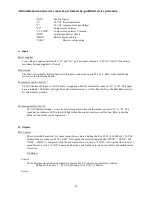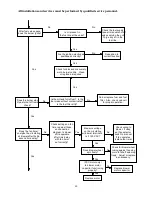
All installations and services must be performed by qualified service personnel.
34
combustion efficiency. However, the CO
2
and O
2
values recommended are slightly
less, though this means slightly lower efficiency, to allow the burner to better tolerate
adverse operating conditions, such as a cold heat exchanger, downdraft conditions,
heating content changes in the fuel. This working tolerance means less service and
maintenance during heating seasons as well as a reduced chance of producing carbon
monoxide under adverse conditions.
2.
CARBON MONOXIDE (CO): As described above, take a flue gas sample from the
flue pipe or vent connector at a position close to the furnace. The amount of CO
generated by combustion ideally should be zero or only a trace. In all cases, it must be
less than 50 PPM. Carbon monoxide is a colorless and odorless gas, but it is toxic
compound. The production of significant quantities of CO is a strong indicator of
incomplete combustion. Check the fuel supply and the burner for fuel leakage. Check
for an inadequate supply of clean air for combustion. Also, check for a restricted or
blocked flue, vent, or chimney.
3.
SMOKE: (oil burners only) A smoke sample should be drawn from the flue pipe or
vent connector at a position close to the furnace. For the greatest efficiency, if the first
smoke reading is “0”, close the air shutter on the burner until a trace smoke reading is
obtained.
4.
FLUE GAS TEMPERATURE: The flue gas temperature will vary to some degree
depending on the heating content of the fuel, the amount of combustion air, and
airflow across heat exchanger. In general, the lower the stack temperature, the higher
the efficiency. However, stack temperatures under 350°F may cause flue gases to
condense, which in turn may cause excessive metal corrosion.
5.
TEMPERATURE RISE: Supply air temperature (measured twelve inches into trunk,
away from radiant heat from the furnace) minus (-) return air temperature, or
Temperature rise = Supply air temperature - Return air temperature.
The temperature rise across the furnace heat exchanger operating at steady-state
conditions (about 15 to 20 minutes) should not exceed 75°F. The normal comfort
range is between 45°F to 75°F. A lower temperature rise usually results in a higher
system efficiency.
:
If the temperature rise exceeds 75°F, the heat exchanger may fail, voiding
the heat exchanger warranty resulting in property damage, personal injury or loss of
life.
M. FLUE GAS COMBUSTION ANALYSIS
:
Burner adjustments must be confirmed by instrumentation. Failure to
use accurate or calibrated instrumentation to correctly setup the burner may result in
reduced efficiency, sooting, and/or the production of hazardous carbon monoxide gas.
Содержание OME-72D36
Страница 2: ......
Страница 7: ...All installations and services must be performed by qualified service personnel 4a...
Страница 21: ...All installations and services must be performed by qualified service personnel 18 Figure 6...
Страница 33: ...All installations and services must be performed by qualified service personnel 30 WIRING DIAGRAM...
Страница 34: ...All installations and services must be performed by qualified service personnel 31...
Страница 53: ...All installations and services must be performed by qualified service personnel 50...
Страница 54: ...All installations and services must be performed by qualified service personnel 51...
Страница 55: ......












































